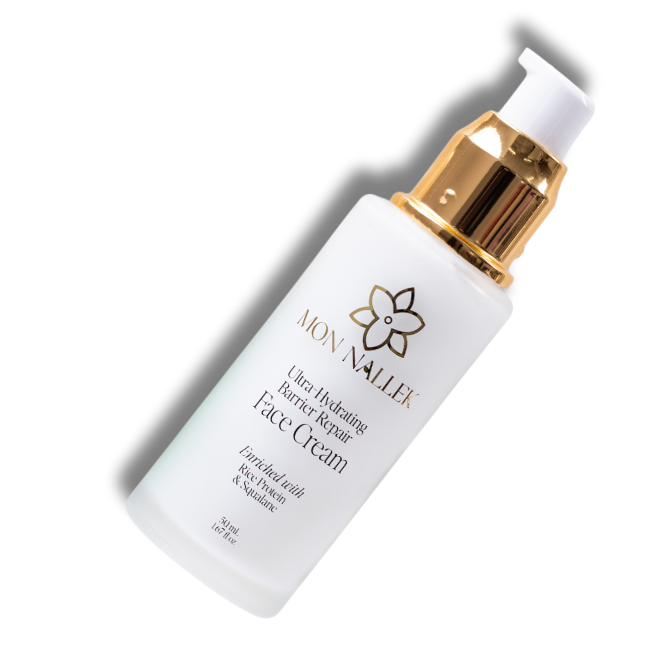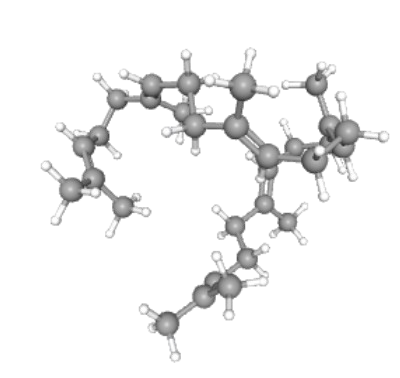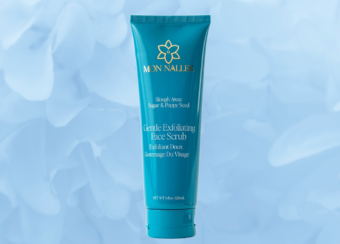Ultra Hydrating- Squalane Vs Squalene
February 5, 2025 2025-04-17 17:19Ultra Hydrating- Squalane Vs Squalene

Feel the ultimate answer to facial skin moisture retention and barrier protection with Mon Nallek’s Ultra Hydrating Barrier Repair Face Cream. Uniquely designed for deep moisture penetration and long lasting hydration, this cream is formulated to restore and strengthen the skin’s natural protective barrier. Created with clean, effective ingredients, it seeks to nurture a healthier more resilient skin, while soothing and softening the face. Whether you have dry, sensitive, or acne-prone skin, this luxurious cream is a must-have in your daily skincare routine.
At the very center of our formulation is olive derived squalane, a highly stable and effective emollient that is non-comedogenic in nature. Known for its ability to penetrate deep within the epidermis without clogging the skin’s pores, this compound is highly similar to natural lipids ( or fats) found in human skin oils known as sebum. This makes it the perfect ingredient in our cream for retaining moisture and promoting that luxurious skin texture. It absorbs seamlessly, without the oily touch and leaves the skin feeling soft and smooth.
What is Squalane?
Squalane is a naturally occurring compound found in both plants and animals. In humans, Squalane is produced when squalene is hydrogenated to form a more stable compound that is part of the production of sebum. Squalene is synthesized using the Mevalonate (MVA) Biosynthesis Pathway. These pathways occur in the liver, as well as the skin.
Sebum, a natural oil secreted by the sebaceous glands, serves as a crucial component in maintaining skin health. Its composition is a sophisticated mixture of lipids, each playing a unique role:
- Triglycerides, accounting for about 41% of sebum, provide moisture and softness.
- Wax esters, making up approximately 26%, help in creating a protective layer to reduce water loss.
- Squalene, at around 12%, is a potent antioxidant that guards the skin against oxidative stress.
- Free fatty acids, contributing roughly 16%, offer antimicrobial benefits and support skin barrier function.
- Cholesterol esters, present in smaller quantities (2–4%), aid in maintaining the integrity of the skin barrier.
- Diglycerides, found in trace amounts, complete the lipid profile. Interestingly, the composition of sebum evolves over time and varies between species. In newborns, sebum closely resembles that of adults for the initial 3 to 6 months of life. Afterward, from ages 1 to 8, it shifts, showing an increase in cholesterol content and a decrease in wax esters and squalene. Puberty marks a surge in sebum production, which gradually tapers off as you age. Though sebum itself lacks any odor, bacterial activity on the skin can break down the fatty acids, resulting in noticeable smells.
How is squalane different from squalene, its natural precursor?
Squalane is different from squalene both in its structure and functionality. Structurally, Squalene has thirty (30) Carbons and fifty (50) with alternating double and single bonds between the carbons as shown in figure 1 and figure 2 . This causes squalene to have a kinked structure . Functionally, squalene is a great compound to form other important molecules in the body which includes cholesterols that help in the formation of steroids such as Testosterone and progesterone and estrogen. Squalane has thirty (30) Carbon atoms and sixty two ( 62) hydrogen atoms as shown in figure 3. This occurs during the hydrogenation of the squalene derivative. Functionally squalane aids primarily in occlusion that helps increase skin hydration by reducing water loss through the skin.
Figure 1: 2D structure of Squalene.

Figure 2: 3D structure of Squalene.

Figure 3: 2D Structure of Squalane

Why has squalane gained popularity in skincare?
Both squalene and squalane are found in sebum and offer numerous functions and benefits to the skin. Peroxidation, which occurs when an excited singlet oxygen (1ΔO2) reacts with lipids, results in the formation of free radicals that damage cells and accelerate the aging process. Singlet oxygen plays a significant role in oxidative damage, and its interaction with squalene primarily leads to the formation of lipid peroxides, contributing to aging and inflammation.
However, squalane, unlike squalene, contains no double bonds in its structure. Since singlet oxygen cannot react with squalane in the same manner, it offers superior protection to human skin surfaces by preventing lipid peroxidation caused by UV light or sunlight and other oxidative stressors. This stability is one of the key reasons why the skincare industry extensively uses squalane in products, particularly those formulated for facial care.
The skin is the largest organ of the body due to its multifunctional nature and the vital roles it performs. It acts as a protective barrier, shielding internal cells and organs from foreign pathogens, helps regulate body temperature, produces vitamin D, and defends against harmful UV radiation. Another important function of the skin’s lipid bilayer is regulating water retention by repelling water molecules, thanks to the high content of long-chain fatty acids in the epidermis. Fats like squalane, which are structurally similar to the skin’s natural lipids, can penetrate the upper layers of the skin called the epidermis and integrate into the lipid bilayer, helping to strengthen the skin barrier and retain moisture. With the retention of that water hydration it helps the skin look more supple by retaining its elasticity reducing the generation of micro wrinkles and gives your skin that gleaming glow. Squalane is also lipid soluble and comedogenic in nature, which means squalane is allowed to dissolve within the epidermal layer of the skin without clogging your pores.
Benefits of Squalane for Different Skin Types
Squalane is suitable for oily and acne prone skin because of its amazing unique properties. It enhances the epidermal barrier by absorbing right into the epidermal bilayer thus adding extra strength and keeping in that much needed water hydration. It is non comedogenic in nature thus not clogging the pores, It works as an antioxidant against free radicals caused by the sun and other environmental factors. Squalane also has an anti- inflammatory properties which reduces irritation caused by acne. It also helps regulate the overproduction of sebum as it is similar in nature to sebum.
Processes and Formulation
Mon Nallek’s Ultra Hydrating Barrier Repair Face Cream, has been formulated with, You! the customer in mind and the understanding that facial skin is one of the most important parts of a person’s character. That is why, we have sourced the finest squalane oil, extracted from olive, a fruit that is rich in squalane content and refined to perfection. Olive squalane is highly stable due to its hydrocarbon unsaturated structure therefore it is less prone to oxidation. This hydrocarbon saturation improves the shelf life of Mon Nallek’s Cream.
Squalane enhances the absorption of other active ingredients by integrating into the lipid matrix of the epidermal layer without clogging pores. This process softens the skin, creating an optimal environment for the penetration of water-soluble active ingredients, such as hyaluronic acid and niacinamide. Simultaneously, it facilitates the assimilation of fat-soluble ingredients, like the lipids in jojoba oil and grapeseed oil, further enhancing the skin’s softness and soothing properties.
Sustainability and Ethical Considerations:
As we, at Mon Nallek continue to provide you with the best quality product, we ensure that our ingredients including squalane are plant based and sourced from reputable distributors. Thus ensuring that our product remains cruelty free. By choosing plant-based squalane, the skincare industry not only promotes sustainability but also helps preserve marine life and reduce environmental impact. It’s Renewable! It’s Eco Friendly!
Conclusion: Why Should You Add Squalane to Your Skincare Routine?
Morning Routine
Step 1: Use the Mon Nallek Gentle Exfoliating Face Scrub – Wash your face with a gentle cleanser to remove overnight buildup of dead skin, dirt and skin oils..
Step 2: Use the Mon Nallek Moisture Rebalancing Face Toner – Use a toner to balance your skin’s pH.Scrubbing can disrupt the skin’s natural pH balance, and a toner helps bring it back to normal.
Step 3: Apply Mon Nallek Gleaming Antioxidant Face Oil – Layer our oil-based face oil that is rich in vitamin C. Vitamin C is a powerful antioxidant that neutralizes free radicals generated by environmental stressors like UV rays and pollution. Applying it in the morning after washing your face helps fortify your skin’s natural defenses throughout the day.
Step 4: Apply Mon Nallek Ultra Hydrating Barrier Repair Face Cream – Apply a few drops of our squalane-based moisturizer to lock in hydration and enhance the absorption of serums.

Author:
Kerron Ottley-
Degree in Biochemestry & Analytical Chemistry
Search
Categories




